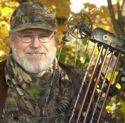Have you seen a flying squirrel?
Not Rocky the Flying Squirrel, the jet propelled star of the 1959-1964 animated television series, but the southern flying squirrel (Glaucomys volans).
This nocturnal tree squirrel is native to Kentucky, but seldom seen. Many outdoor enthusiasts spend a lifetime afield and just get a glimpse or two of these secretive, diminutive squirrels.
Kentucky’s two other species of tree squirrels — the eastern gray (Sciurus carolinensis) and the northern fox (Sciurus niger) — are abundant and popular game animals, hunted during fall and spring seasons.

While flying squirrels may not be hunted, they do have predators — raccoons, foxes, weasels, bobcats, hawks, and owls.
Description
Flying squirrels are members of family Sciuridae which includes 44 small to medium-sized rodents, from tree squirrels, ground squirrels, chipmunks, marmots (including woodchucks), to prairie dogs. The earliest known squirrels date from the Eocene, a geologic period that ended about 34 million years ago.
Smaller than gray squirrels, flying squirrels have large black eyes, prominent ears, long whiskers, and a flat, furry tail with a rounded tip.
The upper body, head and tail are drab olive to gray, with dark, almost black edges. The underbelly, throat, chest and lower tail are creamy white to grayish.
About 8 to 10 inches long (which includes its 4-inch tail), the southern flying squirrel weighs just 3 ounces.
Deciduous and mixed forests are their primary habitat, but they do occasionally reside in small stands of conifers, especially where mature beech and oaks are nearby.
Flying squirrels are nocturnal and omnivorous, eating mostly nuts, fruit, seeds, buds, flowers, insects, gastropods (snails), spiders, fungi, bird eggs and tree sap.
Although they forage on the ground, flying squirrels spend most of their time in trees, where they climb, walk, or run along branches.
Males are less aggressive than females, and their home ranges may overlap. During the winter, individuals of both sexes may nest communally, presumably to conserve body heat.
Home range size is variable but averages about one acre for females and one-and-a-half acres for males.
How They Fly
Flying squirrels are not capable of flight in the same way as birds or bats, but glide from tree to tree with the aid of a patagium, a furry membrane that stretches from wrist to ankle. Anatomically, flying squirrels are very similar to other tree squirrels but their limb bones are longer, and their hand and foot bones are shorter and more flexible.
The flying squirrel’s ability to glide from tree to tree is unique among rodents.

Before gliding, a flying squirrel bobs and rotates its head, perhaps to gauge the route.
As the squirrel sails downward, it twists and turns, to avoid branches, and changes direction with the aid of its tail, which serves as a rudder. Just as it nears the destination, the flying squirrel gives puts on the brakes, with an upward jerk of the tail.
Fleshy pads on the feet cushion the shock of impact, and sharp claws clasp the bark.
A single glide usually covers about 30 feet, but when initiated from a tall tree and oriented downslope, a flight may extend more than 270 feet.
During gliding, flying squirrels emit high frequency sounds which may serve in echolocation.
Geographic Range
The geographic range of the southern flying squirrel is basically the eastern half of the U.S., from the northern Great Plains, to New England, south to Florida, and west to Texas.
For more outdoors news and information, see Art Lander’s Outdoors on KyForward.
Its range overlaps somewhat with the northern flying squirrel (Glaucomys sabrinus), in the Great Lakes states, and northern Appalachian states. The northern flying squirrel’s range extends through the forested areas of Canada, south to New England, the Pacific coast and northern Rocky Mountains in the U.S.
The southern flying squirrel is found statewide in Kentucky.
Reproduction
There have been comparatively few studies of the reproduction of the southern flying squirrel in the wild.
But these studies indicate that litters are present in April and May and again in August and September. The gestation period is 40 days. The average litter size is three to four.
Young flying squirrels weigh less than an ounce at birth, are pink, blind, and without hair except for short whiskers. Their eyes open at 28 days. Weaning occurs at 35 to 42 days, when the young are fully furred, nearly the same size as an adult and begin to practice gliding skills. By ten weeks they are ready to leave the nest.
Females may move their litters to clean nests, usually made of shredded bark, leaves, moss, lichens and feathers, located in tree cavities, especially abandoned woodpecker holes.
The young may stay with their mother until she bears another litter. Most females bear young at two years of age.
Vocalizations
Vocalizations are one of the main clues to the presence of this secretive species.
The vocal repertoire includes many bird-like calls, from chirps and clucks, to high-pitched, repetitive sneeze-like sounds. Loud squeals often accompany chasing and mating. Young emit high-pitched squeaks.
The secretive world of the flying squirrel is one of nature’s many wonders. Consider yourself lucky if you get to see a squirrel in flight, on the way to your outdoors destination at the beginning or end of the day, in the mystical low light of dawn or dusk.
Art Lander Jr. is outdoors editor for NKyTribune and KyForward. He is a native Kentuckian, a graduate of Western Kentucky University and a life-long hunter, angler, gardener and nature enthusiast. He has worked as a newspaper columnist, magazine journalist and author and is a former staff writer for Kentucky Afield Magazine, editor of the annual Kentucky Hunting & Trapping Guide and Kentucky Spring Hunting Guide, and co-writer of the Kentucky Afield Outdoors newspaper column.























Dear Art,,
Would like to send you a video I made of flying Squirrels on my Feeder.
I am lucky to see these little creatures just about every night. They come after dark 6 to 8 PM and stay till they are full of Corn off the cob.
Also, I would love to have a person with a high speed Camera get some footage
Message if you have any interest
This is great keep it up sir
Good for my studies